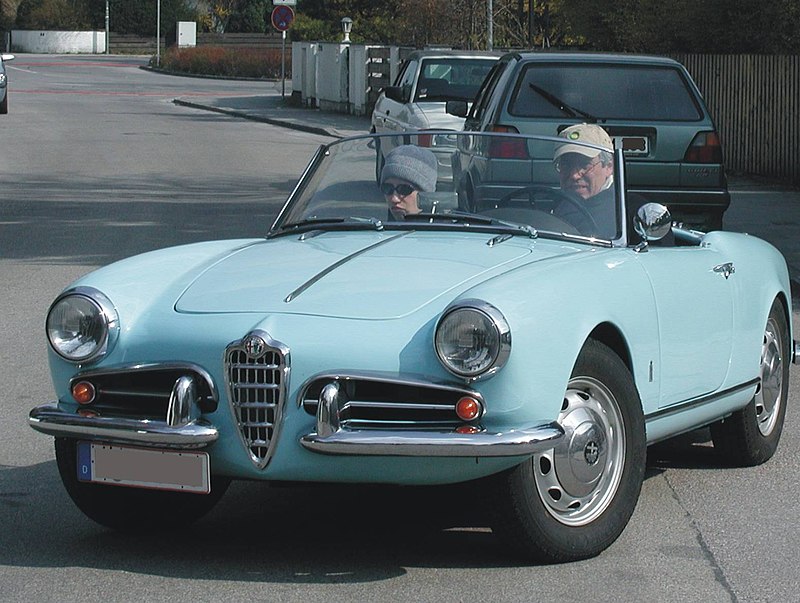1950-1958 1900
The Alfa Romeo 1900 is an automobile produced by Italian car manufacturer Alfa Romeo from 1950 to 1959. Designed by Orazio Satta, it was an important development for Alfa Romeo as the marque's first car built entirely on a production line and first production car without a separate chassis. It was also the first Alfa Romeo offered with left-hand drive. The car was introduced at the 1950 Paris Motor Show.
The 1900 was offered in two-door or four-door models, with a new 1,884 cc (bore 82.55 mm (3.3 in), stroke 88 mm (3.5 in)), 90 bhp (67 kW), 4-cylinder twin cam engine. It was spacious and simple, yet quick and sporty. The slogan Alfa used when selling it was "The family car that wins races", not-so-subtly alluding to the car's success in the Targa Florio, Stella Alpina, and other competitions. In 1951 the short wheelbase 1900C (c for corto (Italian for short)) version was introduced. It had a wheelbase of 2,500 mm (98.4 in).[4] In the same year the 1900TI with a more powerful 100 bhp (75 kW) engine was introduced, it had bigger valves, a higher compression ratio and it was equipped with a double carburetor. Two years later the 1900 Super and 1900 TI Super (also 1900 Super Sprint) with 1975 cc engine were introduced (bore increased to 84.5 mm (3.3 in), stroke unchanged). The TI Super had two double carburetors and 115 bhp (86 kW). Transmission was a 4-speed manual on basic versions and 5-speed manual in Super Sprint version, the brakes were drum brakes. The 1900 had independent front suspension (double wishbones, coil springs and hydraulic telescopic shock absorbers) and live rear axle.
1951-1953 Matta
The Alfa Romeo 1900 M (better known by its nickname Alfa Romeo Matta, meaning "mad") is a four-wheel drive utility vehicle produced by Italian car manufacturer Alfa Romeo from 1951 to 1954. Developed on request of the Italian Ministry of Defence, it was made in both military (AR 51) and civilian (AR 52) versions.
The AR 51 (Autovettura da Ricognizione, "Reconnaissance Car") was the result of the request of a light reconnaissance vehicle for use on paved, unpaved and mountain roads. A civilian version, the AR 52, was later developed from the military AR 51; several variants were made, adapted for use in agriculture, firefighting, and road maintenance.
The Matta was built from 1952 to 1954, with 2,007 military AR 51s for the Italian Army and 154 civilian AR 52 units produced. In 1954, the Italian army abandoned the AR 51 and switched to the Fiat Campagnola, which was mechanically simpler.
1954-1962 Giulietta
The Alfa Romeo Giulietta (Tipo 750 and Tipo 101, meaning "Type 750" and "Type 101") was a family of automobiles made by Italian car manufacturer Alfa Romeo from 1954 to 1965 which included a 2+2 coupé, four-door saloon, estate, spider, Sprint, and Sprint Speciale. The 2+2 was Alfa Romeo's first successful foray into the 1.3-litre class. From 1954 to 1965 a total of 177,690 Giuliettas were made, the great majority in saloon (Berlina), Sprint coupé, or Spider body styles, but also as Sprint Speciale and Sprint Zagato coupés, and the rare Promiscua estate.
1958-1962 2000
The Alfa Romeo 2000 (officially known as Tipo 102, Italian for Type 102) is a luxury car produced by Italian car manufacturer Alfa Romeo between 1958 and 1962, as a successor to the 1900 Super. It was replaced in 1962 by the Alfa Romeo 2600.
The 2000 was presented in 1957 at the Turin Motor Show, with 4-door, 6-seater saloon Berlina body. Production started in 1958, and the car was available as Berlina or Spider convertible. In 1960, the Sprint coupé was added. The 2000 Berlina had gearbox operated via column-mounted shifter making space for three people in front. The two grand touring versions had the gear lever located in floor, and a higher output engine. Until 1961, when 2+2-seater became available, the Spider was a pure two-seater. The last 2000s were built in 1962, when the improved six-cylinder Alfa Romeo 2600 was phased in.
1959-1964 Dauphine
Renault Dauphine (pronounced [dɔfin]) is a rear-engined economy car manufactured by Renault in a single body style – a three-box, 4-door saloon – as the successor to the Renault 4CV; more than two million were manufactured during its 1956-1967 production.
Along with such cars as the Volkswagen Beetle, Morris Minor, Mini and Fiat 500, the Dauphine pioneered the modern European economy car.
Renault marketed variants of the Dauphine, including a sport model, the Gordini, a luxury version, the Ondine, the 1093 factory racing model, and the Caravelle/Floride, a Dauphine-based two-door coupé and two-door convertible.












.jpg/1024px-Alfa_Romeo_1900_L_(1952).jpg)

.jpg/800px-1M_ZA_183SD_(17665878508).jpg)







.jpg/800px-1956_Alfa_Romeo_Giulietta_Spider_-_Flickr_-_The_Car_Spy_(2).jpg)

.jpg/1024px-1959_Alfa_Romeo_Giulietta_SS_1300_(15929396314).jpg)













.jfif)


No comments:
Post a Comment